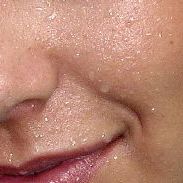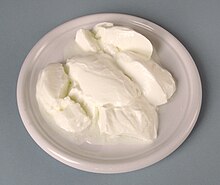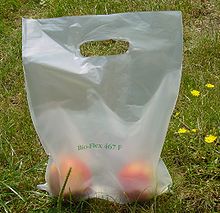Lactic acid
| Structural formula | ||||||||||||||||||||||
|---|---|---|---|---|---|---|---|---|---|---|---|---|---|---|---|---|---|---|---|---|---|---|

|
||||||||||||||||||||||
| Structural formula without specifying the stereochemistry | ||||||||||||||||||||||
| General | ||||||||||||||||||||||
| Surname | Lactic acid | |||||||||||||||||||||
| other names | ||||||||||||||||||||||
| Molecular formula | C 3 H 6 O 3 | |||||||||||||||||||||
| Brief description |
colorless, almost odorless, oily liquid (racemate) |
|||||||||||||||||||||
| External identifiers / databases | ||||||||||||||||||||||
|
||||||||||||||||||||||
| Drug information | ||||||||||||||||||||||
| ATC code | ||||||||||||||||||||||
| properties | ||||||||||||||||||||||
| Molar mass | 90.08 g · mol -1 | |||||||||||||||||||||
| Physical state |
liquid (racemate) |
|||||||||||||||||||||
| density |
1.21 g cm −3 (racemate) |
|||||||||||||||||||||
| Melting point |
|
|||||||||||||||||||||
| boiling point |
122 ° C (20 hPa ) (racemate) |
|||||||||||||||||||||
| Vapor pressure |
10 Pa (25 ° C) |
|||||||||||||||||||||
| pK s value |
3.90 (25 ° C, racemate) |
|||||||||||||||||||||
| solubility | ||||||||||||||||||||||
| Refractive index |
1.4392 (20 ° C; racemate) |
|||||||||||||||||||||
| safety instructions | ||||||||||||||||||||||
|
||||||||||||||||||||||
| Toxicological data | ||||||||||||||||||||||
| As far as possible and customary, SI units are used. Unless otherwise noted, the data given apply to standard conditions . Refractive index: Na-D line , 20 ° C | ||||||||||||||||||||||
Lactic acid ( Latin acidum lacticum ) is a hydroxycarboxylic acid , so it contains both a carboxy group and a hydroxyl group . It is therefore also known as 2-hydroxypropionic designated by the nomenclature recommendations of the IUPAC , however, is the name 2-hydroxypropanoic to use. The salts and esters of lactic acid are called lactates .
history
Lactic acid has historically been used both in Europe and in Asia to acidify and preserve food, especially milk ( sour milk ), vegetables (e.g. sauerkraut ) and also for the production of silage as animal feed for centuries or millennia.
The first discovery and isolation of lactic acid goes back to the Swedish chemist Carl Wilhelm Scheele in 1780, who isolated it from sour milk in the form of a brown syrup. Meat lactic acid [ L - (+) - lactic acid] was discovered by Jöns Jakob Berzelius in 1808 and its structure was clarified in 1873 by Johannes Wislicenus . Henri Braconnot , a French chemist, found out in 1813 that lactic acid can be made in a fermentation process. 1856 saw Louis Pasteur , the lactic acid bacteria and developed the basic understanding of the lactic acid fermentation . Large-scale production of lactic acid began in the USA in 1881, and in 1895 Boehringer Ingelheim also made the discovery of how lactic acid could be produced in large quantities with the help of bacteria.
properties
Lactic acid in the form of lactate is an important intermediate product in the metabolism , for example as a product in the breakdown of sugars through lactic acid fermentation . Around 250,000 tons of lactic acid are produced industrially around the world every year (as of 2010), which are mainly used in the food industry and for the production of polylactides (PLA; also: polylactic acids ).
The specific angle of rotation for D -lactic acid at 20 ° C is [α] D 20 = -2.6 (H 2 O) and for L -lactic acid [α] D 20 = +2.6 (H 2 O). At 15 ° C an angle of rotation [α] D 15 = +3.82 (H 2 O) is measured for L -lactic acid .
Lactic acid forms intermolecular esters . Lactoyllactic acid is formed as a dimer with the elimination of water , which further esterifies to polylactic acid when left standing for a long time or when heated. However, these macromolecules do not reach any relevant chain lengths in order to be able to utilize the product technically.
In aqueous lactic acid solution, there is a chemical equilibrium between lactic acid and its polyesters ( estolides ) formed by intermolecular dehydration . In 90% lactic acid solution, about 70% is found as free acid and 20% as its estolide. Two lactic acid molecules form dilactide with a six-membered ring (di lactone ) with ring closure and elimination of two water molecules . However, this compound is not observed in aqueous lactic acid solution. High -quality polyesters can be produced from dilactides by means of ring - opening polymerization . The resulting plastic is biodegradable and also immunologically neutral.
Isomerism
Due to their different optical activity , D - (-) - lactic acid ( syn .: ( R ) -lactic acid) is also known as levorotatory lactic acid and L - (+) - lactic acid (syn .: ( S ) -lactic acid) also as dextrorotatory Called lactic acid . Racemic lactic acid is a 1: 1 mixture of ( R ) - and ( S ) -lactic acid. ' L ' stands for Latin laevus = "lying on the left", ' D ' for Latin dexter = "right".
| Isomers of lactic acid | ||
| Surname | L -lactic acid | D -lactic acid |
| other names | ( S ) -lactic acid (+) - lactic acid meat lactic acid |
( R ) -lactic acid (-) - lactic acid |
| Structural formula |  |

|
| CAS number | 79-33-4 | 10326-41-7 |
| 50-21-5 (unspecified) 598-82-3 ( racemate ) |
||
| EC number | 201-196-2 | 233-713-2 |
| 200-018-0 (unspec.) | ||
| ECHA info card | 100.001.088 | 100.030.636 |
| 100,000,017 (unspec.) | ||
| PubChem | 107689 | 61503 |
| 612 (unspec.) | ||
| Wikidata | Q27080955 | Q27077083 |
| Q161249 (unspec.) | ||
Occurrence
L - (+) - lactic acid occurs in sweat , blood , saliva, as well as in muscle serum, kidneys and bile . The racemate , a 1: 1 mixture of D - and L -lactic acid, is found, for. B. in sour milk and whey products, tomato juice and beer. In all products that are preserved by lactic acid fermentation , the proportion of the two enantiomers depends on the bacterial strain used and the reaction conditions.
Also fungi produce lactic acid, eg. B. Representatives of the genera Rhizopodus, Allomyces and Blastocladiella.
Manufacturing
Lactic acid can be produced both biotechnologically through fermentation of carbohydrates (sugar, starch) and synthetically based on petrochemical raw materials ( acetaldehyde ).
Fermentative production
About 70 to 90% of the world production of lactic acid is currently fermentatively produced, both the pure enantiomers are commercially produced by fermentation process with lactic acid bacteria in significant amounts. As a rule, only one of the stereoisomers is formed in a strain-specific manner, but the enzyme lactate racemase can also lead to other mixing ratios.
Industrially, sour milk products are produced by fermenting milk or whey , primarily using the Lactobacillus species Lactobacillus acidophilus , Lactobacillus casei , Lactobacillus delbrueckii subsp. bulgaricus ( Lactobacillus bulgaricus ) and Lactobacillus helveticus , furthermore by Streptococcus salivarius subsp. thermophilus ( Streptococcus thermophilus ) and Lactococcus lactis . For industrially used lactic acid, sugar syrup or starch hydrolysates and Lactobacillus delbrueckii as well as pentose- containing sulphite waste liquors and Lactobacillus pentosus are used. The bacterial strains are classified according to their peculiarity to ferment glucose only to lactate or to other products: homofermentative species, such as Lactobacillus casei and Lactococcus lactis , produce two moles of lactate per mole of glucose, while heterofermentative species such as Leuconostoc mesenteroides and Lactobacillus brevis , alongside one mole of lactate per mole of glucose will also produce acetic acid , carbon dioxide and ethanol .
One advantage of fermentative production is that - unlike synthetic production - it is stereospecific. In this way, the L -isomer, which is in greater demand for modern applications, can be produced with certain strains .
Synthetic manufacture
Lactic acid is synthetically produced by the addition of hydrogen cyanide ( hydrogen cyanide , HCN) to acetaldehyde to form acetaldehyde cyanohydrin (lactic acid nitrile , lactonitrile). The nitrile is then hydrolyzed to lactic acid and ammonium chloride with hydrochloric acid . This synthesis route is being implemented by the Japanese company Musashino as the last major producer of synthetic lactic acid.
use
Nutrition, feed and luxury foods
A number of foods are made directly through lactic acid fermentation. This mainly includes sour milk products such as sour milk, yogurt , kefir and buttermilk . These are produced by infecting pasteurized milk with starter cultures of lactic acid bacteria. Other products are lactofermented vegetables such as sauerkraut , beetroot in some borscht varieties or kimchi, as well as sourdough and corresponding sourdough products. Silages, fresh feed made durable through fermentation, are also based on lactic acid fermentation.
As a food additive , lactic acid bears the designation E 270. It is used in many different ways as an acidulant in the food and luxury goods industry, for example in baked goods, confectionery and occasionally in lemonades. By changing the pH value in the food to a pH of about 4, the food is preserved, as colonization with other microorganisms is largely excluded.
In the form of the salts calcium lactate or calcium lactate gluconate , it can also be added for calcium enrichment.
Material use
Lactic acid is the monomer of polylactides or polylactic acids (PLA), which are used in a variety of ways as biodegradable and bio-based plastics .
Lactic acid has an antibacterial effect and is therefore added to liquid soaps, detergents and dishwashing detergents . The disinfecting effect unfolds optimally at a pH value of 3 to 4. It was and is also used as a means of contraception.
Lactic acid is used as a descaling agent in the tannery for descaling hides. It is also used for this purpose in the textile industry and printing . Some cleaning tabs for coffee machines , water machines and similar devices that contain lactic acid as a lime remover.
Beekeepers use lactic acid to treat bees against the Varroa mite , whereby it must be ensured that the treated beehives or honeycombs are brood-free. Arachnologists use lactic acid to lighten the prepared epigyne of female spiders or other chitin structures and to dissolve remnants of tissue.
The pharmaceutical technology uses lactic acid, water-insoluble drugs in salts of lactic acid (Lactate) convert; these are more soluble in water (example: ciprofloxacin ).
In cosmetics, lactic acid is used in skin creams and other products to treat acne .
physiology
If the skeletal muscles are exercised vigorously, the blood lactate content can rise from 5 mg / dl to 100 mg / dl. The reason is that under anaerobic conditions, such as when the skeletal muscles are exercised quickly, energy in the form of NAD + must be obtained from the reduction of pyruvate by means of lactate dehydrogenase in order to continue glycolysis . The resulting lactic acid (lactate and H + ) is flushed out of the cells via the monocarboxylate transporter 1 . This process was previously thought to be the cause of sore muscles , but today this theory is largely considered incorrect.
For humans, dextrorotatory L - (+) - lactic acid is the physiological one. Taken orally, it is broken down more quickly in the organism than the levorotatory D - (-) - lactic acid.
Web links
- Kathrin Einütz: Testing the effectiveness of various methods to reduce the germ load on hand-held meat production equipment. Dissertation. FU Berlin, 2004 urn : nbn: de: kobv: 188-2004002043 (Antibacterial and preservative properties of lactic acid)
- 3D representation of both lactic acid molecules for comparison (L- and D-lactic acid)
Individual evidence
- ↑ Entry on E 270: Lactic acid in the European database for food additives, accessed on June 27, 2020.
- ↑ entry to LACTIC ACID in CosIng database of the European Commission, accessed on February 25 2020th
- ↑ a b c d e f g h Entry on lactic acid in the GESTIS substance database of the IFA , accessed on February 1, 2016(JavaScript required) .
- ↑ a b c d e Entry on lactic acid. In: Römpp Online . Georg Thieme Verlag, accessed on March 10, 2011.
- ↑ David R. Lide (Ed.): CRC Handbook of Chemistry and Physics . 90th edition. (Internet version: 2010), CRC Press / Taylor and Francis, Boca Raton, FL, Physical Constants of Organic Compounds, pp. 3-318.
- ↑ Entry on Lactic acid in the ChemIDplus database of the United States National Library of Medicine (NLM)
- ↑ a b c d Surinder P. Chahal, John N. Starr: Lactic Acids. In: Ullmann's Encyclopedia of Industrial Chemistry . Wiley-VCH, Weinheim 2012, doi : 10.1002 / 14356007.a15_097.pub2 .
- ↑ Wim Soetart, Erick J. Vandamme (Ed.): The Scope and Impact of Industrial Biotechnology. In: Industrial Biotechnology. Sustainable Growth and Economic Success. Wiley-VCH , Weinheim 2010, ISBN 978-3-527-31442-3 , p. 9 (English).
- ↑ Werner Eisner et al .: Element Chemistry II Complete Volume . Ernst Klett Verlag, Stuttgart 2000, ISBN 3-12-756700-6 , p. 343 .
- ↑ Hans G. Schlegel: General microbiology. 8th edition. Thieme, 2008.
- ^ Hans-Josef Endres, Andrea Siebert-Raths: Technical Biopolymers. Hanser-Verlag, Munich 2009, ISBN 978-3-446-41683-3 , p. 103.
- ^ J. Crosby: Chirality in Industry - An Overview. In: AN Collins, GN Sheldrake, J. Crosby (Eds.): Chirality in Industry. Wiley, Heidelberg 1992, ISBN 0-471-93595-6 , p. 10.
- ↑ a b Christoph Syldatk and Rudolf Hausmann: Organic acids . In: Hermann Sahm, Garabed Antranikian, Klaus-Peter Stahmann & Ralf Takors (eds.): Industrial microbiology . Springer Spectrum, Berlin, Heidelberg 2013, ISBN 978-3-8274-3039-7 , chap. 5 , p. 92-107 , doi : 10.1007 / 978-3-8274-3040-3 .
- ^ Hans G. Schlegel, Christiane Zaborosch: General microbiology . 7th edition. Thieme Verlag, Stuttgart / New York 1992, ISBN 3-13-444607-3 , p. 296-304 .
- ↑ Christoph Syldatk : Organic acids. Acetic acid (acetate). In: Garabed Antranikian: Applied Microbiology. Springer-Verlag, Berlin / Heidelberg 2006, ISBN 3-540-24083-7 , pp. 344–347.
- ↑ a b c Rolf D. Schmid: Pocket Atlas of Biotechnology and Genetic Engineering. 2nd Edition. Wiley-VCH, Weinheim 2006, ISBN 3-527-31310-9 , pp. 12-13.
- ↑ Kathrin Einütz: Testing of the effectiveness of various methods to reduce the germ load on hand-held devices for meat production. Dissertation. FU Berlin, 2004 urn : nbn: de: kobv: 188-2004002043 .
- ↑ Magnus Hirschfeld: sex studies. Volume 2, 1930, pp. 454f.
- ↑ Instructions for use lactic acid 15% ad us. vet. Serumwerk Bernburg AG, as of January 14, 2009.
- ^ Axel Kleemann , Jürgen Engel, Bernd Kutscher, Dietmar Reichert: Pharmaceutical Substances. 4th edition. 2 volumes. Thieme-Verlag, Stuttgart 2000, ISBN 1-58890-031-2 , pp. 482-484 (online since 2003 with biannual additions and updates).
- ↑ Dieter Thierbach: Riddle of everyday life - what is right-turning lactic acid?



